
Catalog excerpts
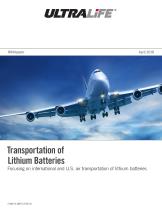
Transportation of Lithium Batteries Focusing on international and U.S. air transportation of lithium batteries
Open the catalog to page 1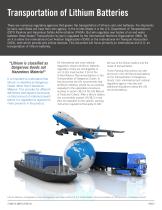
Transportation of Lithium Batteries There are numerous regulatory agencies that govern the transportation of lithium cells and batteries. For shipments by land, each State will have their own agency. In the Unites States it is the U.S. Department of Transportation’s (DOT) Pipeline and Hazardous Safety Administration (PHSA). But who regulates over bodies of air and water between these States? Transportation by sea is regulated by the International Maritime Organization (IMO). By air it is either the International Civil Aviation Organization (ICAO) or the International Air Transport...
Open the catalog to page 2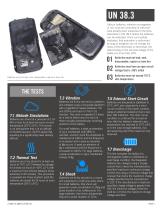
UN 38.3 Lithium batteries, whether rechargeable or not, must be comprised of cells that have already been subjected to the tests described in UN 38.3 before the batteries can be evaluated. Once successfully evaluated, that evaluation is authorized as long as designers do not change the mass of the electrodes or electrolyte, the rated energy or the nominal voltage of the battery by more than 20%. Batteries must not leak, vent, disassemble, rupture or have fire not leak, vent, 01 Batteries mustrupture or have fire disassemble, Batteries must have 02 voltage that is ≥90%an open circuit initial...
Open the catalog to page 3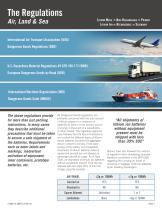
Lithium Metal = Non-Rechargeable = Primary Lithium Ion = Rechargeable = Secondary International Air Transport Association (IATA) Dangerous Goods Regulations (DGR) U.S. Hazardous Material Regulations 49 CFR 100-177 (HMR) European Dangerous Goods by Road (DGR) International Maritime Organization (IMO) Dangerous Goods Code (IMDGC) The above regulations provide for more than just packing instructions. In many cases they describe additional precautions that must be taken to ensure a safe shipment of the batteries. Requirements such as outer labels and markings, inadvertent activation of...
Open the catalog to page 4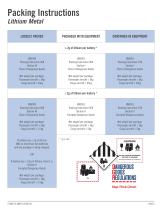
Packing Instructions Lithium Metal LOOSELY PACKED PACKAGED WITH EQUIPMENT > 2g of lithium per battery * UN3090 Packing Instruction 968 Section IA Class 9 Dangerous Goods UN3091 Packing Instruction 969 Section I Class 9 Dangerous Goods UN3091 Packing Instruction 970 Section I Class 9 Dangerous Goods Net weight per package: Passenger aircraft = 0kg Cargo aircraft ≤ 35kg Net weight per package: Passenger aircraft ≤ 5kg Cargo aircraft ≤ 35kg Net weight per package: Passenger aircraft ≤ 5kg Cargo aircraft ≤ 35kg ≤ 2g of lithium per battery * UN3090 Packing Instruction 968 Section IB Class 9...
Open the catalog to page 5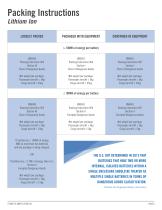
Packing Instructions Lithium Ion LOOSELY PACKED PACKAGED WITH EQUIPMENT > 100Wh of energy per battery UN3480 Packing Instruction 965 Section IA Class 9 Dangerous Goods UN3481 Packing Instruction 966 Section I Class 9 Dangerous Goods UN3481 Packing Instruction 967 Section I Class 9 Dangerous Goods Net weight per package: Passenger aircraft = 0kg Cargo aircraft ≤ 35kg Net weight per package: Passenger aircraft ≤ 5kg Cargo aircraft ≤ 35kg Net weight per package: Passenger aircraft ≤ 5kg Cargo aircraft ≤ 35kg ≤ 100Wh of energy per battery UN3480 Packing Instruction 965 Section IB Class 9...
Open the catalog to page 6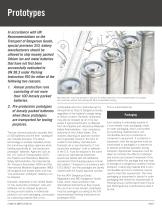
Prototypes In accordance with UN Recommendations on the Transport of Dangerous Goods, special provision 310, battery manufacturers should be allowed to ship loosely packed lithium ion and metal batteries that have not first been successfully evaluated to UN 38.3 under Packing Instruction 910 for either of the following two reasons: 1. Annual production runs consisting of not more than 100 loosely packed batteries. 2. Pre-production prototypes of loosely packed batteries when these prototypes are transported for testing purposes. The low volume production quantity limit of 100 batteries and...
Open the catalog to page 7
Quantities The total gross mass of the package, including equipment of different sizes, shapes or masses, must not exceed the gross mass for which the package design type has been tested. • A battery with a net mass of more than 30 kg is limited to one battery per outer packaging. • For batteries with a Watt-hour rating equal to or less than 312.5Wh, no more than 12 batteries per package is allowed. • For batteries with Watt-hour rating greater than 312.5Wh, no more than six batteries per package is allowed. • No single package may contain greater than 6,250Wh. • The gross weight of a...
Open the catalog to page 8All Ultralife Corporation catalogs and technical brochures
-
Ultralife Thin Cell Brochure
5 Pages
-
Ultralife 9V Infographic
1 Pages
-
Batteries for Robotics
5 Pages
-
Ultralife XR123A Sell Sheet
1 Pages
-
Ultralife CR123A Sell Sheet
1 Pages
-
Lithium 9V vs Alkaline 9V
7 Pages
-
A-320 20-Watt Amplifier
4 Pages
-
Toll Pass Capabilities
2 Pages
-
Medical Capabilities
2 Pages
-
AN/PRC-117G
3 Pages
-
Metering Capabilities
2 Pages
-
AN/PRC-117F
3 Pages
-
AN/PRC-152
3 Pages
-
MRC-170
1 Pages
-
Communications Solutions
4 Pages


































